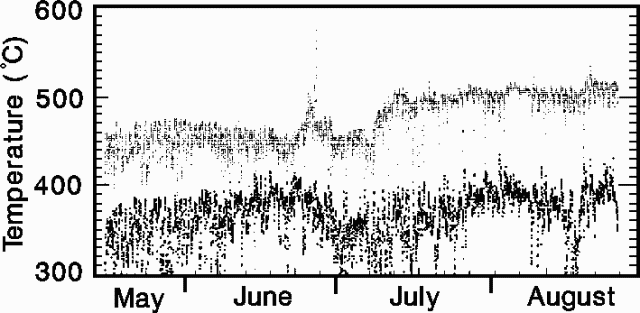Report on Colima (Mexico) — August 1991
Bulletin of the Global Volcanism Network, vol. 16, no. 8 (August 1991)
Managing Editor: Lindsay McClelland.
Colima (Mexico) Fumarole temperatures increase
Please cite this report as:
Global Volcanism Program, 1991. Report on Colima (Mexico) (McClelland, L., ed.). Bulletin of the Global Volcanism Network, 16:8. Smithsonian Institution. https://doi.org/10.5479/si.GVP.BGVN199108-341040
Colima
Mexico
19.514°N, 103.62°W; summit elev. 3850 m
All times are local (unless otherwise noted)
"Five high-temperature fumaroles on the SW rim of the summit lava dome have been monitored continuously since May. These fumaroles are ~75 m W of the site of the March-May lava extrusion and occur along fractures radial to the dome. Temperatures were measured at 20-minute intervals and radio-telemetered to the Science Center in the city of Colima. Temperatures at two of the fumaroles have increased at a steady rate between May and August (figure 16). Mean late-August temperatures were 506 and 386°C, increases of 66 and 43°C, respectively, since May. Mean temperatures in three other fumaroles have changed <10°C during the same period. Throughout the sampling period, all fumaroles exhibited marked diurnal temperature variation, on the order of 30-80°C/day. The rainy season, which began in mid-June and has continued through August, has had little effect on fumarole temperatures other than occasional low readings during rainstorms."
Geological Summary. The Colima complex is the most prominent volcanic center of the western Mexican Volcanic Belt. It consists of two southward-younging volcanoes, Nevado de Colima (the high point of the complex) on the north and the historically active Volcán de Colima at the south. A group of late-Pleistocene cinder cones is located on the floor of the Colima graben west and east of the complex. Volcán de Colima (also known as Volcán Fuego) is a youthful stratovolcano constructed within a 5-km-wide scarp, breached to the south, that has been the source of large debris avalanches. Major slope failures have occurred repeatedly from both the Nevado and Colima cones, producing thick debris-avalanche deposits on three sides of the complex. Frequent recorded eruptions date back to the 16th century. Occasional major explosive eruptions have destroyed the summit (most recently in 1913) and left a deep, steep-sided crater that was slowly refilled and then overtopped by lava dome growth.
Information Contacts: C. Connor, FIU, Miami.


